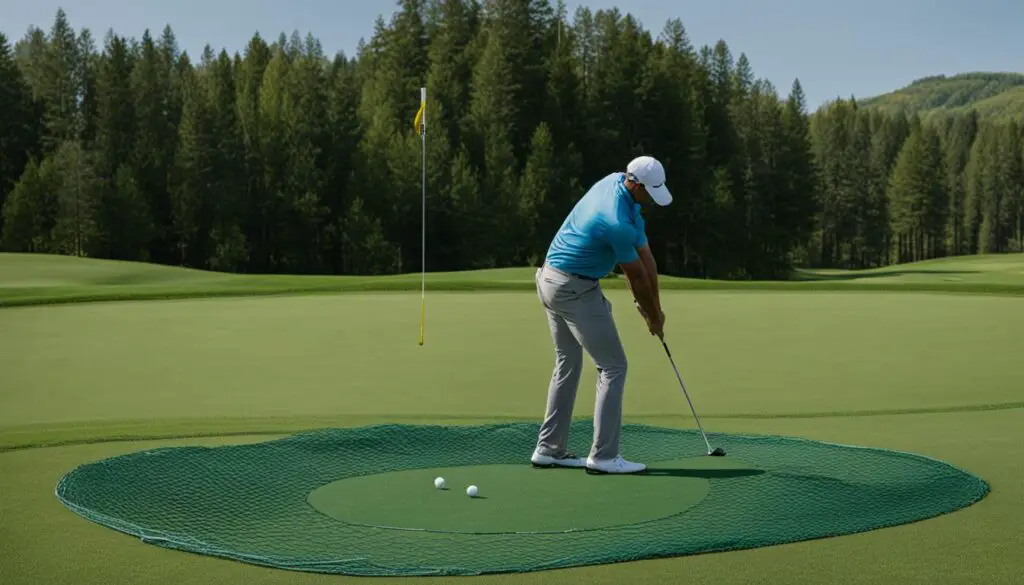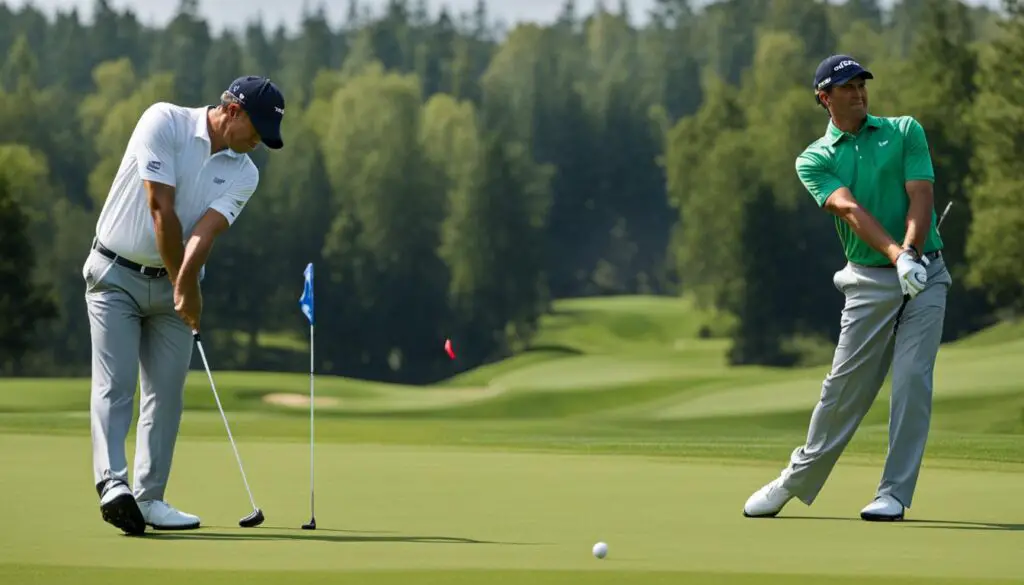Welcome to our comprehensive guide on how to properly swing a golf club. Whether you’re a beginner looking to improve your game or an experienced golfer seeking to fine-tune your technique, mastering your swing is the key to success on the course. In this article, we will walk you through the essential steps and techniques to help you achieve a more consistent and powerful swing.
Golf swing mechanics can be complex, but by breaking down the process into specific sections, we’ll cover everything you need to know to improve your swing and boost your performance. From the importance of proper alignment and grip to understanding the backswing and executing the downswing, each component plays a crucial role in developing a solid swing.
Follow along as we delve into the intricacies of each element, providing you with practical tips and techniques to refine your swing and enhance your overall game. By the end of this article, you’ll have a clear understanding of the fundamental principles behind a proper golf swing and be armed with the tools necessary to take your swing to the next level.
Key Takeaways:
- Proper alignment and stance are crucial for a successful golf swing.
- A proper grip allows for better clubhead rotation and accuracy.
- The backswing sets up the power and sequence of the swing.
- The downswing generates the power and speed of the swing.
- A balanced follow-through indicates a well-executed swing.
The Importance of Proper Alignment and Stance
Proper alignment and stance are fundamental to a good golf swing. Setting up correctly before even taking a swing can greatly improve your chances of hitting the ball accurately and consistently. Here are some key tips to help you master the art of alignment and stance:
- Positioning: Start by positioning your front foot slightly ahead of the ball. This promotes a more shallow angle of attack and allows you to strike the ball with a descending blow, resulting in better contact and more distance.
- Alignment: Ensure that your feet, hips, and shoulders are aligned parallel to the target line. This helps you square the clubface at impact and minimizes the chances of slicing or hooking the ball.
- Balanced Stance: Maintain a slight bend in your knees and distribute your weight evenly on both feet. This balanced stance provides a stable foundation for your swing and allows for proper weight transfer throughout.
Remember, a good alignment and stance set the stage for a solid swing. Take the time to establish these fundamentals correctly, and you’ll be on your way to hitting more accurate and powerful shots.
Now that you understand the importance of alignment and stance, let’s move on to the next section, where we will dive into the intricacies of mastering the golf grip.
Related keyword: golf swing fundamentals, golf swing techniques
Mastering the Golf Grip
When it comes to improving your golf swing, mastering the grip is one of the most critical aspects. The way you hold the club directly affects your swing mechanics and overall performance. Experiment with different grips, such as the baseball grip, overlap grip, or interlocking grip, to find the one that feels most comfortable for you.
Remember to hold the club with a relaxed grip to allow for proper clubhead rotation and accuracy during the swing. A common mistake is gripping the club too tightly, which can restrict your wrist action and result in poor ball contact. On the other hand, a grip that is too loose can lead to inconsistency and lack of control. Find the right balance where you feel in control of the club without gripping it too tightly.
Proper grip pressure and alignment of your hands are essential for achieving a solid and consistent swing. The ‘V’ created by your thumb and index finger should point towards your right shoulder (for right-handed golfers). This promotes a square clubface at impact and helps ensure a straighter ball flight. Practice your grip regularly, focusing on maintaining a neutral hand position and consistent grip pressure throughout your swing.
As you continue to work on your grip, remember that it is just one piece of the overall puzzle. While a proper grip is crucial, it should be combined with other fundamental aspects of the swing, such as alignment, stance, and body rotation. By mastering the golf grip and integrating it with other important elements, you will be well on your way to improving your golf swing mechanics and achieving greater consistency and distance.
Understanding the Backswing
The backswing is a critical component of the golf swing mechanics, setting the stage for a powerful and well-executed shot. It involves a series of coordinated movements that allow you to generate the necessary power and position for a successful downswing. Here are some key points to keep in mind when it comes to understanding the backswing:
Golf Swing Fundamentals: Rotating the Torso
During the backswing, focus on rotating your torso to build up the potential energy required for a powerful shot. This rotation should be smooth and controlled, allowing your upper body to turn away from the target while keeping your lower body stable. It’s important to maintain a straight front arm throughout the backswing, ensuring proper club alignment and swing plane.
Golf Swing Mechanics: Hinging the Wrists
Another crucial aspect of the backswing is hinging the wrists. As you bring the club back, allow your wrists to naturally hinge, forming an angle between the clubshaft and your lower arm. This wrist hinge helps to create leverage and store energy, which will be released during the downswing for maximum power and clubhead speed.
“The backswing sets the foundation for a successful swing. Focus on rotating your torso and hinging your wrists to generate power and position for the downswing.” – Golf Pro
Golf Swing Fundamentals: Maintaining a Straight Front Arm
Throughout the backswing, it’s important to maintain a straight front arm. This not only helps to keep the club on the correct swing plane but also ensures proper sequencing and timing of the swing. Keep your front arm extended and allow it to guide the club smoothly back, avoiding any excessive bending or collapsing.

Understanding the backswing is essential for mastering the golf swing fundamentals. By focusing on rotating your torso, hinging your wrists, and keeping a straight front arm, you’ll be able to build up power and position for a successful downswing. Practice these techniques with patience and consistency, and you’ll see improvement in your overall swing mechanics.
Executing the Downswing
Once you have mastered the backswing, it’s time to focus on executing the downswing. This is where the power and speed of your swing are generated, leading to solid ball contact and increased distance. To achieve a successful downswing, follow these key techniques:
“Shift your weight from the back foot to the front foot, allowing your arms and body to unwind through the impact area.”
Start by shifting your weight from your back foot to your front foot as you start the downswing. This weight transfer helps generate power and allows your arms and body to unwind naturally through the impact area. It’s important to maintain a smooth transition and avoid any sudden movements or jerks.
As you initiate the downswing, keep your front arm straight and extend it toward the target. This helps maintain the proper swing plane and promotes a solid strike. Additionally, use your hips to initiate the rotation of your body, transferring energy into the shot.
Finally, focus on striking the ball before your clubhead moves through the ground. This ensures clean contact and optimal ball flight. Remember, the downswing should feel fluid and controlled, allowing for maximum power and accuracy.
Common Mistakes to Avoid
- Rushing the downswing: Maintain a smooth and controlled tempo throughout the entire swing.
- Losing posture: Keep your body and spine angle intact to avoid mishits.
- Overusing the hands: Use your body’s rotation, not just your hands and arms, to generate power.
- Coming over the top: Ensure your club stays on the correct swing plane to prevent slicing the ball.
By focusing on these downswing techniques and avoiding common mistakes, you’ll be on your way to a more powerful and consistent golf swing.
Achieving a Balanced Follow-Through
When it comes to mastering your golf swing, achieving a balanced follow-through is often overlooked but essential. A balanced follow-through demonstrates a well-executed swing and increases the chances of hitting the ball accurately. To achieve this, focus on maintaining a smooth rotation of your body, with your weight mostly on the front foot, and hold your finish until the ball lands.
During your follow-through, allow your body to naturally continue rotating towards the target. This rotation helps to maintain your balance and control throughout the swing. Additionally, make sure that your weight is mostly on the front foot, as this promotes a more powerful and accurate strike.
Remember, the follow-through is not just a “wind-down” after the swing; it is an integral part of the overall motion. By practicing and perfecting your follow-through, you can improve your golf swing mechanics and see significant improvement in your game.

Tips for a Balanced Follow-Through:
- Focus on maintaining a smooth rotation of your body towards the target.
- Keep your weight mostly on the front foot during the follow-through.
- Hold your finish until the ball has landed to ensure proper execution.
“A balanced follow-through indicates a well-executed swing and increases the chances of hitting the ball accurately.”
By incorporating these tips into your practice routine, you can improve your golf swing mechanics and achieve a balanced follow-through. Remember, consistency and repetition are key, so dedicate regular practice time to refining your swing. With time and effort, you will see noticeable improvement in your golf game.
Correcting Common Swing Mistakes
Even experienced golfers can fall into bad habits that affect their swing. Addressing common swing mistakes is essential for improving your game and achieving better results on the course. Here are some tips to help you correct these errors and enhance your golf swing:
1. Check your grip:
A proper grip is crucial for a successful swing. Make sure your hands are positioned correctly on the club, with the V between your thumb and index finger pointing towards your trailing shoulder. Avoid gripping the club too tightly, as it can limit your clubhead speed and accuracy.
2. Assess your alignment:
Misalignment can cause inconsistent shots or missed targets. Check that your feet, hips, and shoulders are square to the target line. Use alignment markers or alignment aids to ensure you’re aiming correctly. Proper alignment sets the foundation for a consistent and accurate swing.
3. Focus on swing plane:
A poor swing plane can lead to slices or hooks. Visualize a plane extending from the ball through your body and beyond. During your swing, keep the club on this plane as much as possible. Practice drills that promote a proper swing plane, such as swinging with a headcover or alignment stick.
4. Maintain a consistent tempo:
Many golfers rush their swings, resulting in poor contact and inconsistent shots. Develop a smooth and controlled tempo by practicing with a metronome or counting in your head. A consistent tempo helps synchronize your body movements and leads to more consistent ball-striking.
By addressing these common swing mistakes and focusing on improving your technique, you can make significant strides in your golf game. Take the time to practice and refine your swing, and you’ll see noticeable improvements in your performance on the course.
Practicing Proper Iron Swing
Improving your iron swing is essential for enhancing your golf game. By mastering this skill, you’ll be able to hit accurate shots and navigate the course with confidence. To help you improve your iron swing, we’ve compiled a list of effective golf swing drills that will refine your technique and lead to better results on the fairway.
1. Tee Height Drill
Start by teeing up the ball higher than usual and practice hitting it. This drill encourages you to strike the ball on a downward trajectory, promoting a solid impact and generating more backspin. Gradually lower the tee until you’re able to take divots after striking the ball. Remember to maintain a centered ball position and a slightly forward lean of the shaft.
2. Tour Tempo Drill
Use a metronome or a swing tempo app to establish a consistent rhythm in your iron swing. The tour tempo drill is based on the concept that a successful swing has a specific ratio between the backswing and the downswing. Practice syncing your body and club movement with the metronome, aiming for a smooth and balanced swing that generates maximum power.
3. Impact Bag Drill
An impact bag is a training aid that helps you develop a powerful and accurate strike. Start by resting the clubhead on the impact bag and assume your address position. Swing the club and make contact with the bag, focusing on proper hand and arm extension, body rotation, and weight transfer. This drill will improve your overall feel for impact, leading to better ball compression and control.
Remember, consistency is key when it comes to improving your iron swing. Dedicate regular practice time to these drills, focusing on refining your technique and developing a smooth, repeatable swing motion. With time and effort, you’ll see significant improvement in your iron play, leading to lower scores and a more enjoyable golf experience.

Practice is essential for honing your golf swing. In the next section, we’ll dive into mastering the driver swing, where we’ll discuss techniques to maximize your distance off the tee and optimize your performance on long par-5s and challenging fairways.
Mastering the Driver Swing
When it comes to golf, the driver swing is the key to achieving maximum distance off the tee. To improve your driver swing, it’s important to focus on proper technique and incorporate effective drills into your training routine. Here are some golf swing drills that can help you master the driver swing and enhance your overall performance:
1. Tee Height Drill
One common mistake golfers make with their driver swing is improper ball tee height. To practice the correct tee height, take a few practice swings with the ball teed up high, almost level with the crown of the driver. This drill will help you achieve the desired upward angle of approach, allowing you to launch the ball higher and maximize distance.
2. Slow-Motion Swing
Another useful drill is the slow-motion swing. By emphasizing the tempo and rhythm of your driver swing, you can improve your timing and generate more power. Take a few practice swings with a slow and controlled motion, focusing on maintaining balance and smoothness throughout the swing. This drill will help you develop a consistent and fluid driver swing.
3. Target Practice
A great way to refine your driver swing is by incorporating target practice into your training sessions. Set up targets, such as flags or markers, at different distances and aim to hit each target with your driver. This drill will help you improve your accuracy and trajectory control, ensuring that you can consistently hit the ball where you want it to go.
By incorporating these golf swing drills into your training routine, you can enhance your driver swing and take your game to the next level. Remember to practice with consistency and focus on proper technique. With time and dedication, you’ll see improvement in your distance and accuracy off the tee.
The Role of Posture in the Swing
Proper posture is a fundamental aspect of a successful golf swing. Having the correct posture not only helps with balance and stability but also allows you to generate maximum power and accuracy in your swing. Here are some key points to consider when it comes to posture:
- Keep a slight bend in your knees: This helps to maintain an athletic stance and allows for better weight transfer during the swing.
- Hinge at the hips: Bend forward from your hips to achieve a forward tilt of your upper body. This promotes a proper swing plane and allows for optimal rotation through the swing.
- Tilt your upper body away from the target: This helps to create the necessary space for your arms to swing freely and encourages a proper swing plane from the backswing through the downswing.
By maintaining a solid and balanced posture throughout your swing, you set yourself up for success. It is also important to remember that everyone’s posture may be slightly different, so finding a comfortable and natural posture that works for you is key. Practice your posture regularly and seek feedback from a golf instructor to ensure you are on the right track.

The Key Elements of a Successful Swing
Mastering a successful golf swing involves several key elements that work together to create a fluid and effective motion. By understanding and implementing these elements, you can significantly improve your golf game. Let’s explore these fundamental aspects of a successful swing:
1. Alignment and Stance
Proper alignment and stance form the foundation of a good golf swing. Position your front foot slightly ahead of the ball and ensure that your feet, shoulders, and hips are aligned with your target. Maintain a balanced stance with a slight bend in the knees and distribute your weight evenly on both feet. This alignment and stance will set you up for a more powerful and accurate swing.
2. Grip
A proper grip is crucial for achieving consistent and controlled swings. Experiment with different grips, such as the baseball grip, overlap grip, or interlocking grip, to find the one that feels most comfortable for you. Remember to hold the club with a relaxed grip, allowing for proper clubhead rotation and accuracy during the swing.
3. Backswing
The backswing sets the stage for generating power and sequencing in your swing. Focus on rotating your torso and hinging your wrists while keeping the club on the correct swing plane. Maintain a straight front arm and rotate your chest as you bring the club back.
4. Downswing and Follow-Through
The downswing is where you generate power and speed in your swing. Shift your weight from the back foot to the front foot, allowing your arms and body to unwind through the impact area. Keep your front arm straight and ensure the clubhead strikes the ball before moving through the ground. The follow-through is equally important, indicating a well-executed swing. Maintain a smooth rotation of your body and hold your finish until the ball lands.
By mastering these key elements of a successful swing, you’ll be well on your way to improving your golf game and enjoying greater consistency and accuracy on the course.
Understanding Swing Plane and Tempo
When it comes to mastering your golf swing, understanding the concepts of swing plane and tempo is essential. These two factors play a significant role in achieving consistency and accuracy in your swing. Let’s take a closer look at what swing plane and tempo mean and how they can improve your golf game.
The Importance of Swing Plane
Swing plane refers to the path that your club follows during your swing. It is important to maintain a proper swing plane to ensure clean contact with the ball and generate maximum power. A consistent swing plane allows for a fluent and repeatable swing, resulting in better ball-striking ability. To achieve the correct swing plane, focus on keeping the club on the desired path throughout your swing, whether it’s a straight back and straight through or slightly inside to out.
The Role of Tempo
Tempo refers to the rhythm and timing of your swing. It is the cadence at which you transition from the backswing to the downswing and ultimately strike the ball. A smooth and controlled tempo promotes a more efficient swing and helps maintain proper mechanics. Finding the right tempo for your swing is a personal preference, but it should be consistent and balanced. Practice with a metronome or work with a golf instructor to develop a tempo that feels comfortable and allows for optimal performance.

Improving Swing Plane and Tempo
To improve your swing plane and tempo, there are several drills and exercises you can incorporate into your practice routine. Here are a few examples:
- Use alignment sticks or a club shaft to create a visual guide for your swing plane.
- Practice slow-motion swings, focusing on maintaining a smooth and balanced tempo.
- Utilize video analysis tools to review your swing and identify areas for improvement.
- Work with a golf instructor to receive personalized guidance and feedback.
By dedicating time and effort to improving your swing plane and tempo, you will see significant improvements in your overall golf game. Remember, consistency is key, so practice regularly and stay focused on refining these important aspects of your swing.
The Mental Aspect of the Swing
The mental aspect of the golf swing is often underestimated, yet it has a significant impact on your performance on the course. While the physical mechanics of the swing are crucial, your mindset plays a vital role in executing the perfect shot. To improve your golf swing, it’s essential to develop a strong mental game.
One key element of a successful mental approach is having a pre-shot routine. This routine helps you get into the right mindset before each swing and instills a sense of confidence and focus. It could involve visualizing your shot, deep breathing exercises, or a specific set of physical movements. Find a routine that works for you and stick to it consistently.
Staying focused throughout your round is another vital aspect of the mental game. It’s easy to get distracted by external factors such as other players or course conditions, but maintaining your focus on the present moment is crucial. Practice techniques like mindfulness or the use of positive affirmations to keep your mind centered and engaged.
Lastly, maintaining a positive attitude is essential for a successful golf swing. Golf is a challenging game, and setbacks are inevitable. Instead of getting frustrated or dwelling on mistakes, adopt a growth mindset and view every shot as an opportunity to learn and improve. Remember, golf is as much a mental game as it is a physical one, and a positive mindset can make a world of difference.
Key Points:
- Develop a pre-shot routine to get into the right mindset before each swing.
- Stay focused on the present moment and avoid distractions.
- Maintain a positive attitude and view every shot as an opportunity to learn and grow.

Practice Makes Perfect
Improving your golf swing requires dedication and practice. To enhance your skills, incorporate a variety of golf swing drills into your training routine. These drills are designed to target specific aspects of your swing, helping you identify areas for improvement and enhance overall performance.
One effective drill is the “swinging gate” exercise. Set up two alignment rods or clubs parallel to each other, creating a gate. Practice swinging your club through the gate while maintaining proper alignment and a smooth swing plane. This drill helps develop consistency and accuracy in your swing.
Another useful drill is the “one-handed swing.” Grip the club with only your lead hand and practice swinging with controlled power. This drill helps improve your grip, wrist action, and overall swing mechanics.
Video analysis tools are also valuable for assessing your swing. Record your swing from different angles and review the footage to identify any flaws or areas for improvement. Seek feedback from a golf instructor who can provide valuable insights and guidance on how to correct common swing mistakes and refine your technique.
FAQ
What are the key steps to properly swing a golf club?
The key steps to properly swing a golf club include proper alignment and stance, a good grip, a solid backswing, a powerful downswing, and a balanced follow-through.
How do I achieve proper alignment and stance?
To achieve proper alignment and stance, position your front foot slightly ahead of the ball, align your feet and shoulders with the target, maintain a slight bend in your knees, and distribute your weight evenly on both feet.
What grip should I use for a golf swing?
Experiment with different grips such as the baseball grip, overlap grip, or interlocking grip to find what feels comfortable for you. Remember to hold the club with a relaxed grip to allow for proper clubhead rotation and accuracy.
How do I execute a proper backswing?
During the backswing, focus on rotating your torso and hinging your wrists, ensuring the club stays on the correct swing plane. Maintain a straight front arm and rotate your chest as you bring the club back.
How do I execute a powerful downswing?
To execute a powerful downswing, shift your weight from the back foot to the front foot, allow your arms and body to unwind through the impact area, keep your front arm straight, and use your hips to transfer energy into the shot.
Why is the follow-through important in a golf swing?
The follow-through is important as it indicates a well-executed swing and increases the chances of hitting the ball accurately. Maintain a smooth rotation of your body, with your weight mostly on the front foot, and hold your finish until the ball lands.
How can I correct common swing mistakes?
To address common swing mistakes such as slicing or hooking the ball, check your grip, alignment, and swing plane. Work on maintaining a consistent swing tempo and focus on brushing the grass under the ball during the swing to achieve good contact and ball flight.
What should I focus on when practicing my iron swing?
When practicing your iron swing, focus on hitting down on the ball. Maintain a centered ball position, a slightly forward lean of the shaft, and a downward strike. Use drills such as teeing up and gradually lowering the tee until you can take divots after striking the ball.
How can I improve my driver swing?
To improve your driver swing, adjust your ball position more forward in your stance, keep a shoulder-width stance, and focus on sweeping the ball off the tee. Practice drills that focus on teeing up the ball correctly and maintaining a smooth swing tempo.
How does posture impact the golf swing?
Proper posture is essential for maintaining balance and power during the swing. Ensure a slight bend in your knees and a hinge at your hips to achieve an athletic posture. Tilt your upper body away from the target to promote a proper swing plane and rotation.
What are the key elements of a successful golf swing?
The key elements of a successful golf swing include proper alignment, grip, stance, backswing, downswing, and follow-through. Each element plays a crucial role in the overall execution of the swing.
What is swing plane and tempo?
Swing plane refers to the path the club follows during the swing, while tempo refers to the rhythm and timing of the swing. Understanding and maintaining a proper swing plane and tempo are vital for consistency and accuracy in your swing.
How does the mental aspect of the swing affect performance?
The mental aspect of the swing greatly impacts performance. Develop a pre-shot routine to get in the right mindset before each swing, stay focused, visualize successful shots, and maintain a positive attitude throughout your round.
How can I improve my golf swing through practice?
Improving your golf swing requires practice and repetition. Incorporate drills and exercises specific to each element of the swing into your practice routine, seek feedback from a golf instructor, and dedicate regular practice time to refining your swing.
